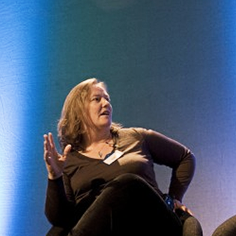
There is no such thing as the news industry anymore. The message was delivered swiftly and with no remorse by Emily Bell, keynote speaker at the 2013 International Journalism Festival in Perugia.
Bell, director of the Tow Center for Digital Journalism at Columbia’s Graduate School of Journalism and leading commentator on media policy in the UK, presented her co-authored essay “Post-industrial journalism: adapting to the present,” a report on the future of digital media.
Bell and co-authors C.W. Anderson and Clay Shirky interviewed over 50 individuals and news organizations to produce the report, ultimately gaining an interesting picture of the current state of American journalism.
What you’ve heard is true: advertising subsidies don’t work in the new media world and no strong evidence exists in favor of subscription models either. Huge newsrooms aren’t fit for the future, they’re too expensive, too slow. Bell thinks the shift is permanent and a complete restructuring of the industry is needed. Journalism will have to be smaller.
“There’s no longer such a thing as “the press” addressing such a thing as “the public,” Bell said. “Those models are gone.”
There used to be one news industry, bonded by its similar methods, monopoly and hierarchy, protected by the fact that it was an exclusive club. However the advent of new media tools gave any interested citizen the ability to produce a competitive product, blurring the traditional roles of newsmaker and audience.
“Adapting to a world where the people formerly known as the audience are not readers and viewers but users and publishers will mean changing not just tactics but also self-conception,” the report states.
Breaking the fortress of traditional news media to be more accessible to the community is a necessary reorganization – a theme brought up repeatedly during this year’s festival. It is no longer an option to separate content from community – the two work better when they work together.
One key way news organizations can do this is through specialization and individualization. The team observed an overwhelming power shift from the institution of the brand to the individual.
“Journalism is shifting from being a packaged product to the actual individual journalist,” Bell said. A trend that just might be the reorganization needed to save the industry. News organizations need to shift their thinking from serving the needs of the brand to enabling its individual journalists – they are the human element that connects with readers and creates a community.
Of course, Bell added, the core journalism skills of recognizing and recounting a story remain. Only the way that it is done has changed – it now depends on understanding what the community is saying, what they need.
It is not an easy process for traditional news, but it is a necessary process to compete in post-industrial journalism. Despite the difficulties, Bell insisted that above all there is only one thing that journalists absolutely have to do: survive.


